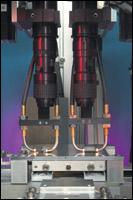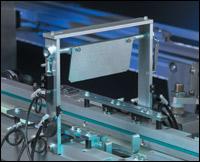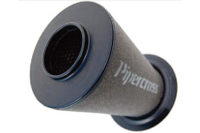|
|
| Two vision cameras monitor a precision dispensing operation on an assembly machine, with two fiber-optic cables providing close-up precision lighting for each camera. |
Automated assembly solves the quantity and quality problems and gradually is being adapted to smaller lot sizes. However, one inherent aspect of automated assembly is the extremely rapid production of scrap when any one of many production factors goes out of control and is not detected immediately. This is a major problem in high-volume operations, and in small-lot automated production as well, where even one off-spec unit means heavy financial loss because of the high value added at each step. Periodic or end-of-line inspection cannot prevent this, and continuous 100 percent manual inspection is both prohibitively expensive and notoriously prone to human error.
Increasingly, integrated 100 percent on-line inspection provides the missing link. Automated inspection can detect problems immediately, increase throughput and yield, cut downtime and improve process control. Automatic real-time inspection and the capability to accumulate comprehensive records also helps in meeting regulatory and legal requirements such as FDA documentation.
Vision systems, lasers, sensors, electrical test systems, leak testers, checkweighers, force gages, torque testers and load cells can all be integrated into automated assembly systems to perform 100 percent test and inspection at high speeds and at relatively reasonable costs.
|
|
| A conveyor carries the product under a pivoting flag. A correctly assembled product passes under the flag. An incorrectly assembled product tips the flag, and a sensor detects the flag movement |
Vision Systems See All
Vision systems today measure dimensions, count quantities, inspect for correct assembly and surface damage, and even compete with sensors in applications requiring fast, foolproof, and largely automatic changeover between related products. Vision systems commonly inspect marking or printing on containers and products, comparing each acquired image with a standard, and accepting or rejecting the product.In most vision applications, correct lighting is critical to reliable operation. It often requires more detailed engineering effort than any other part of the vision system and presents difficult challenges to the machine designer. To avoid difficulties, locations for lamps, mirrors and other lighting elements should be considered carefully in the basic machine design. In some applications, strobe lights can be used to freeze the image, enabling vision systems to effectively inspect products on the fly.
Vision applications also depend heavily on the quality of the algorithms used for control and analysis. While the basic camera and vision system determines the time to acquire an image, the algorithms determine the time to analyze and manipulate the data. The time to perform the analysis can exceed the acquisition time substantially, and may even require investment in multiple parallel inspection stations, more expensive faster vision systems, or other undesirable options.
When the entire vision inspection cycle cannot be completed before the next product is in position for image acquisition, system designers can consider several alternatives. One approach is using more complex controls that allow the analysis to continue during acquisition of the next image. However, this may not be practical if a decision is needed before the product is processed at the next station.
Another approach uses two successive stations, each with a camera, for inspection. Each station inspects every other product, doubling the machine cycle time for image acquisition and analysis. A multi-up inspection can also remove multiple products from their indexing nests and place them into an immediately adjacent auxiliary station for inspection, while simultaneously returning multiple inspected products from the auxiliary station into the empty indexing nests.
Smaller vision cameras support the trend toward integrated inspection. For some simple applications, all necessary controls can be installed in the camera housing. For more complex applications, vision systems typically can control from one to four cameras. Even as vision systems have become more powerful and versatile, prices have steadily fallen, with vision systems suitable for integration now ranging from $2,500 on the low end to more than $50,000 for sophisticated, powerful systems that often include several cameras performing different complex inspections.
One example of a multiple integrated vision system is an assembly machine that feeds, assembles, inspects, sorts and packages two stamped metal parts. Coplanarity of 0.004 inch total variation is required to support soldering to a circuit board. The part is 2 inches square with more than 15 configurations in a wide variety of shapes; changeover is frequent.
A single high-resolution camera, 1,000 by 1,000 pixels, performs the coplanarity inspection, yielding measurement accuracy of 17 microns. The camera is mounted above the part, and four mirrors are fixtured around the edges to provide four side views. The vision system, trained on a reference standard, then makes a best-fit analysis to determine coplanarity. A second camera below the part measures X and Y dimensions using a single 45-degree mirror. A single vision system provides both inspections.
A high-speed processor and a parallel-frame grabber achieve a cycle time of 260 milliseconds from start-test signal to accept-reject answer. The part need be stationary for only 66 milliseconds.
Lasers Are Fast
Only a few years ago, laser sensors were considered exotic, expensive devices; however, lasers are now available for prices well below those of even simple vision systems. Lasers offer key advantages of high speed, extreme accuracy and ease of access. Simple laser sensors, which do no analyses, give results almost instantaneously, and can keep up with virtually any assembly system.The laser sensor's high speed also facilitates inspection of moving targets, often saving machine dwell positions, which reduces machine size and cost. Laser sensors can inspect to an accuracy of 2 or 3 microns and, unlike vision systems, lasers are essentially independent of lighting conditions. These qualities, combined with a reasonable price range--typically $1,000 to $5,000 for a simple system, including amplifier and controls--make lasers ideal for inspection applications that are too difficult for ordinary sensors but not complex enough to require a vision system.
Lasers have proven highly effective in on-line inspection of height differences and dimensions, accurate positioning, and detecting specified product faults. Lasers also have proven uniquely effective in measuring the thickness of a moving part that is too thin for reliable measurement by other means--down to the level of 3 or 4 microns. The thickness of a part presented at a variable angle can still be measured accurately, because the laser spot is so small that the angle effect is virtually meaningless.
Sensors Are Versatile
A variety of simple sensors can confirm completion of motions or myriad other factors. In recent years, sensor capabilities have virtually exploded, with sensor size decreasing drastically, accuracy improving and prices falling. Sensors have become economically justifiable as a means of achieving very high yield, detecting malfunctions immediately, preventing equipment damage and increasing net throughput. Today's automatic assembly machine typically uses from dozens to hundreds of sensors, both with and without integral controls.Sensors can measure displacement to any desired accuracy. The linear variable differential transformer (LVDT), which has been used for decades, is extremely accurate, highly reliable, relatively inexpensive, and can collect data for analysis and corrective action. Noncontact optical, magnetostrictive, inductive, capacitive, eddy current, and other types of sensors provide a wide range of inspection functions. Typical applications include detecting presence and position, and measuring displacement, speed, orientation, planarity and temperature. Sensor arrays can also, with appropriate controls, determine shape, correct assembly and motion characteristics. Such arrays of subminiature sensors are no longer extremely expensive.
Creative application of simple, inexpensive sensors can solve complex problems economically. Here are typical examples:
Incorrectly assembled product. A conveyor carries the product under a contoured plate, or flag, that pivots on a horizontal axis across and above the conveyor. A correctly assembled product passes under the flag. An incorrectly assembled product tips the flag, and a sensor detects the flag movement.
Presence of a spring. >To monitor the presence of a small-wire spring on a shaft, a wide-angle digital sensor measures the change in the amount of through-beam light received during the short interval when the product stops.
Failure of a seal. Baby food jars are evacuated, and so long as the lid seal is intact the jar cap is concave. If the seal fails, air is admitted and the cap becomes flat. A light beam directed at the cap is reflected into a sensor, if the cap is concave. A flat cap reflects the beam incorrectly, identifying a jar with a failed seal. The system inspects 600 jars per minute on a moving conveyor.
Electrical Tests On The Fly
Electrical tests commonly include continuity, conductivity, amperage, voltage, frequency and functional tests. In semiconductor testing, a separate product handling machine typically feeds, contacts, sorts and packages the devices, while a computer-driven tester analyzes data. For other products, electrical tests typically occur within the automatic assembly machine.Electrical tests normally require solid physical contact with the product. However, because the contact surface is often small, special techniques are needed to achieve good electrical contact at high speed. One common method is to use a rotary dial indexer in which each fixture nest positions a product for test under an integral probe plate with multiple flexible leads. As the dial indexes, a fixed cam moves the probe plate so that the leads touch the contact surfaces on the product, scrubbing the surface to penetrate any thin oxide layer to establish good electrical contact.
At several inspection stations, pogo pins then contact the probe plate to take the required readings. This method provides accurate measurements and minimizes damage to the product contact surfaces, because there is only one set of scrub marks.
Many simple electrical tests can be very fast, but complex functional tests may take time. Typically, the needed test time is achieved by either operating an indexing machine multi-up or by using a pallet system. Nontest operations might be one-up in a pallet system, but the test operation is multi-up to gain additional test time.
Leak Tests in Parallel
For automatic assembly machines that perform welding or sealing, the joints often must meet specific leak rate criteria. If the permissible leak rate is high, a simple pressure or vacuum switch can generally perform the test within the machine cycle time. However, single-cycle detection of small leaks is often impractical even with the fastest leak testers.To compensate for longer test times, multiple probes can simultaneously contact the ports of several products during the nest dwell and index with the products through several stations. When the test is completed, the test probes lift off and return for the next multi-up cycle. This method is mechanically somewhat complex and requires additional stations. It also might not be accurate enough for small leaks, because the flexible hoses typically used distort somewhat during the indexing motion and may impact reading accuracy.
An often preferable technique transfers several products temporarily into an auxiliary station immediately adjacent to the indexing dial, where they are tested simultaneously. The tested group is then transferred back into the indexing nests, and the machine computer logs the test data. Rejected units typically are locked out of future operations until they are discharged downstream.
Some products are fully sealed during the assembly process, leaving no port for testing, but must nevertheless be tested on-line. In one approach, products are placed into closely fitted individual chambers which are then evacuated and sealed from the vacuum source and the environment. A pressure change in any chamber indicates a leak from or into the product within it. This process is slow, and performing it automatically at assembly machine speed is usually expensive.
Checkweighers Do Unique Jobs
Checkweighers have been used for many years to monitor fill weights of containers as they pass on a conveyor. In recent years, they have been increasingly deployed to monitor operations in automatic assembly systems. This type of inspection is easiest in pallet systems, because the individual assembly pallet can approach on a conveyor, pass through the checkweigher, and depart on another conveyor. Speed is not generally a problem, because checkweighers are typically faster than assembly machines.
If the weight check addresses the total weight as a control, one checkweigher downstream from assembly is adequate. However, if the check is for presence of a single component or material that represents a small fraction of total weight, both pre- and post-operation weights must typically be checked, using two checkweighers.
Torque, Force And Load Cells
Torque and force testers commonly process products in the assembly nest, but integrating a load cell often requires access from below. In many cases, such access is available through the assembly carrier and nest. When it is not, transfer of the product onto the load cell and simultaneous transfer of an inspected product from the load cell into the assembly nest can often be completed within the machine cycle. When the total of transfer time and load-cell stabilization time exceeds the machine cycle time, two load cells can simultaneously inspect two products every two machine cycles.Putting It All Together
For optimal results in automatic on-line inspection, the devices are typically programmed to alert plant personnel and, under specified circumstances, shut down the machine. If the malfunction does not repeat, the control normally continues machine operation but locks out all downstream operations on the rejected part to avoid further added value. Beyond these standard capabilities, many additional options are available.Human-machine interface displays can graphically show the exact location and type of error. They can also provide detailed graphical instructions for adjustments or repairs. When the product is expensive or when a single inspection may not be conclusive enough to justify product rejection, the machine control can also extend the dwell cycle to provide time for a repeat inspection.
When economically justifiable, a closed-loop control can make adjustments automatically to correct a problem. The control can perform corrections continuously, when triggered by an error of specified magnitude, or at predetermined times. Whether corrections are made upstream or down-stream from the machine, the objective is always to reduce or eliminate scrap.
The control can download results in real time to supervisory or plant computers. This allows production and plant management to monitor quality and throughput continuously without frequent trips to individual assembly operations. Pertinent data can also be downloaded to local and distant computer systems for quality control purposes, inventory control, raw material planning, production and personnel planning, and trend or other analyses.
As product quality standards con-tinue to rise worldwide, automatic 100 percent on-line inspection will increasingly be part of almost any high-speed automatic assembly system. The benefits, in terms of increased quality and decreased cost, will be huge. M
Integrating inspection into assembly systems is the key to high-quality, low-cost, flexible assembly.


